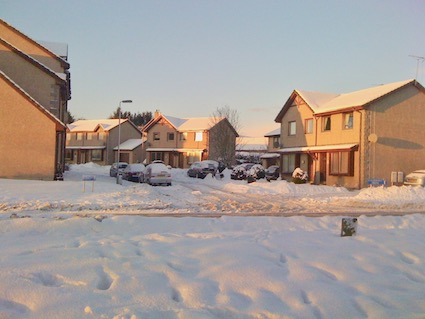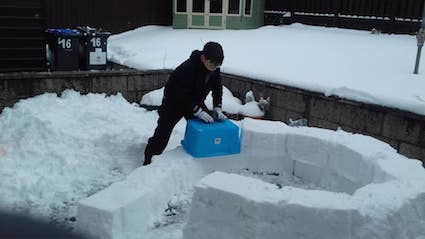
I am an eternal optimist and thus always hope that every winter we will get plenty of snow. It’s so versatile. There’s so many mathematical possibilities linked to snow. So have this blog post tucked away for seizing the moment when the soft stuff falls.
1.Check the thermometer
How cold are the temperatures where you live? Have a look at maximum and minimum temperatures on a thermometer. Plot the temperatures on a graph each day and take a photo to match the weather outside. Discuss why it can be 32 degrees Fahrenheit and zero degrees Celsius when water freezes.
2. How can you reliably measure the amount of snow which has fallen?
This is worth discussing with your class. Because snow can drift, the amount of snow which has fallen can easily be under or over estimated. Go outside and measure the depth of drifts and places that are snow free. Discuss why and how snow drifts. Depending on the age of your children, think about whether measuring in centimetres, millimetres or metres is most appropriate. Have a look at the weather reports and see what is the standard unit of measurement used. Encourage children to convert between the different units. Why is drifting snow a concern?
3. Clothing combos
When it snows, we all like to wrap up warm. If you and another person are each wearing a different hat, jacket, gloves and boots, then how many possible clothing combinations could you create together? If a third person joins you, how many clothing combinations would you now have? Can you work out the quick way of calculating these combinations? A similar problem solver to this is Happy Faces.
4. Explore speed, distance and time by sledging
Set up a run on your favourite sledging hill. If you are able to measure its length between two clearly marked points, that is great. If not, create your own unit of measure – your boot:
- Walk heel to toe beside the run.
- Count the number of steps you take.
- Measure the length of your boot in centimetres.
- Multiple this by the number of steps you took.
- Divide by 100 to get the length of your run in metres.
Now you know the length of your run, you can time yourself with the stop watch facility on a digital device. You can now workout your sledging speed, by dividing the distance in metres by the time in seconds. Compare your speeds to the Olympic results. Think about ways of improving your speed.
5. The larger the snowball, the longer it takes to melt
Is this statement true? What do your children think? Go outside and create a few snowballs of different sizes. Discuss how to measure it. For example:
- Measure its circumference – this is likely to be an approximation, unless you decide to cut your snowball in half to work out the radius.
- Weigh your snowball to find out its mass.
- Wrap it cling film or foil to elicit its very approximate surface area
- The volume of water that is collated as the snowball melts.
Set up a fair test so that you can observe the snowballs melting. Which form of measurement proved to be most accurate?
6. Bulls Eye
Snowballs do not have to be thrown at people. It’s possible to have a range of static targets.
- Using chalk, draw a target board on the side of a building or wall.
- Hang up a hoop
- Using diluted food colouring in spray bottles, children can spray targets onto the ground. First the area has to be stomped down flat. Then draw rings or squares or whatever target and number value you or your children wish with the coloured water. Sticks, flags or wooden spoons can be used to mark the value of each area rather than trying to spray this.
Finally, the children will need to decide the rules. Will it be the best of three snowball shots or the first to 20 points, etc.?
A variation on this is to play games where snowballs are used to knock skittles over, or cans off a wall, or to play a variation of the French game of boules.
7. 3D snow sculptures
Everyone rapidly becomes adept at creating snow spheres (aka snowballs). What other 3D objects are you able to create? A cylinder? Cone? Cube? Cuboid? Square based pyramid? Tetrahedron? Triangular prism. The whole class could work in groups to create a collective giant collection of 3D maths objects. Have fun decorating them afterwards too. Enjoy looking online at the range of amazing snow and ice sculptures that have been created by artists living in snowy climates.
8. How many snowballs can you make in one-minute?
In fresh snow, have one-minute to make as many snowballs as you can. What tactics work best? Does it make a difference if you are wearing gloves? Of course you may need to have a snowball fight after. Just remember to play fair, agree the rules and only throw pure snow with no hidden extras.
9. Invent your own snowshoes
Snowshoes are designed to make walking in soft snow easier. They have been developed by humans living in snowy places world-wide and this Wiki page gives a history. Your class can experiment with making their own from boxboard. Add duct tape if you don’t want them to go soggy. Is it the shape of the snowshoe that makes a difference or its surface area in terms of its effectiveness to make walking through soft snow easier. Perhaps the test is how far one sinks in a patch of deep snow.
10. Build an igloo
This is a lot of work but involves a lot of maths. How many bricks are needed to make each row? Is it better to use large or small containers? What about the tiling construction to ensure stability? How do we pack down the snow to make safe and sturdy blocks of snow?

Finally for a range of playful snow ideas for younger children, check out the 15+ Snow Ideas blog post.
This blog post first appeared in March 2018.



















